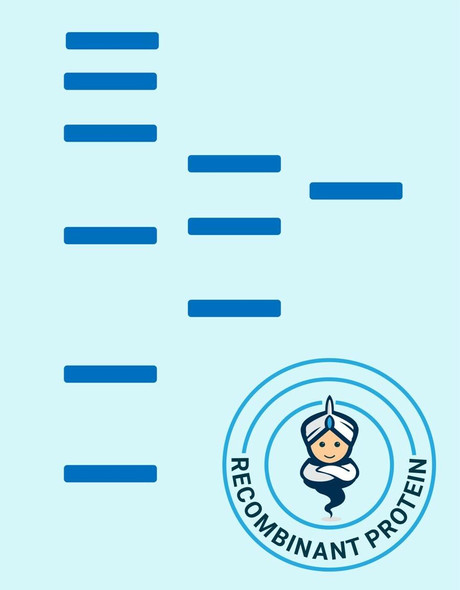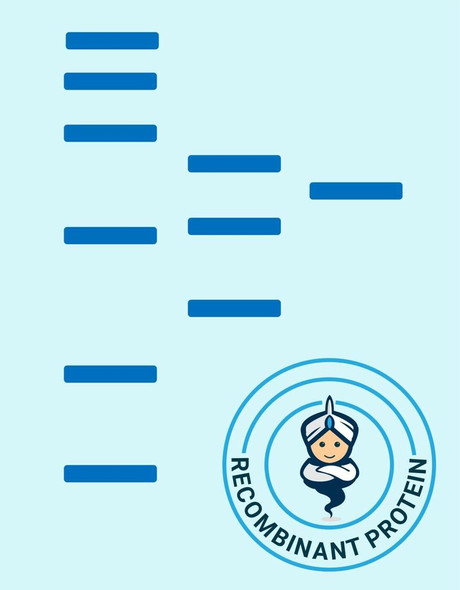Growth Factors & Cytokines Recombinant Proteins
Human VEGI Recombinant Protein (RPPB1089)
- SKU:
- RPPB1089
- Product Type:
- Recombinant Protein
- Species:
- Human
- Uniprot:
- O95150
- Research Area:
- Growth Factors & Cytokines
Description
| Product Name: | Human VEGI Recombinant Protein |
| Product Code: | RPPB1089 |
| Size: | 20µg |
| Species: | Human |
| Target: | VEGI |
| Synonyms: | Tumor necrosis factor ligand superfamily member 15, TNFSF-15, TNFSF15, TNF ligand-related molecule 1, VEGI, TL-1, TL1, TL1A, VEGI192A, VEGI-192, MGC129934, MGC129935. |
| Source: | Escherichia Coli |
| Physical Appearance: | Sterile Filtered White lyophilized (freeze-dried) powder. |
| Formulation: | The TNFSF15 was lyophilized from a 0.2�m filtered concentrated solution in PBS, pH 7.4 with 0.02% Tween-20. |
| Solubility: | It is recommended to reconstitute the lyophilized TNFSF15 in sterile 18M?-cm H2O not less than 100 �g/ml, which can then be further diluted to other aqueous solutions. |
| Stability: | TNFSF15 although stable at room temperature for 3 weeks, should be stored desiccated below -18°C. Upon reconstitution VEGI should be stored at 4°C between 2-7 days and for future use below -18°C.For long term storage it is recommended to add a carrier protein (0.1% HSA or BSA).Please prevent freeze-thaw cycles. |
| Purity: | Greater than 95.0% as determined by:(a) Analysis by RP-HPLC.(b) Analysis by SDS-PAGE. |
| Amino Acid Sequence: | MQLTKGRLHFSHPLSHTKHISPFVTDAPLRADGDKPRAHLTVVRQTPTQHFKNQFPALHWEHELGLAFTKNRMNYTNKFLLIPESGDYFIYSQVTFRGMTSECSEIRQAGRPNKPDSITVVITKVTDSYPEPTQLLMGTKSVCEVGSNWFQPIYLGAMFSLQEGDKLMVNVSDISLVDYTKEDKTFFGAFLL |
| Biological Activity: | The ED50 as determined by its ability to induce apoptosis using human TF-1 cells is less than 20ng/ml, corresponding to a specific activity of > 5.0�104 IU/mg. |
TNFSF15 is a cytokine that belongs to the tumor necrosis factor (TNF) ligand family. This protein is abundantly expressed in endothelial cells, but is not expressed in either B or T cells. The expression of TNFSF15 is inducible by TNF and IL-1 alpha. This cytokine is a ligand for receptor TNFRSF25 and decoy receptor TNFRSF21/DR6. It can activate NF-kappaB and MAP kinases, and acts as an autocrine factor to induce apoptosis in endothelial cells. TNFSF15 is also found to inhibit endothelial cell proliferation, and thus may function as an angiogenesis inhibitor. An additional isoform encoded by an alternatively spliced transcript variant has been reported but the sequence of this transcript has not been determined.
TNFSF15 Human Recombinant produced in E.Coli is a single, non-glycosylated, polypeptide chain containing 180 amino acids and having a molecular mass of 20.5kDa. The TNFSF15 is purified by proprietary chromatographic techniques.
| UniProt Protein Function: | TNFSF15: Receptor for TNFRSF25 and TNFRSF6B. Mediates activation of NF-kappa-B. Inhibits vascular endothelial growth and angiogenesis (in vitro). Promotes activation of caspases and apoptosis. Belongs to the tumor necrosis factor family. 3 isoforms of the human protein are produced by alternative splicing. |
| UniProt Protein Details: | Protein type:Cytokine; Membrane protein, integral; Apoptosis Chromosomal Location of Human Ortholog: 9q32 Cellular Component: extracellular space; integral to plasma membrane; integral to membrane; plasma membrane Molecular Function:death receptor binding; cytokine activity; tumor necrosis factor receptor binding; receptor binding Biological Process: caspase activation; cytokine metabolic process; activation of NF-kappaB-inducing kinase; immune response; signal transduction; positive regulation of cytokine secretion |
| NCBI Summary: | The protein encoded by this gene is a cytokine that belongs to the tumor necrosis factor (TNF) ligand family. This protein is abundantly expressed in endothelial cells, but is not expressed in either B or T cells. The expression of this protein is inducible by TNF and IL-1 alpha. This cytokine is a ligand for receptor TNFRSF25 and decoy receptor TNFRSF21/DR6. It can activate NF-kappaB and MAP kinases, and acts as an autocrine factor to induce apoptosis in endothelial cells. This cytokine is also found to inhibit endothelial cell proliferation, and thus may function as an angiogenesis inhibitor. Two transcript variants encoding different isoforms have been found for this gene. [provided by RefSeq, Feb 2011] |
| UniProt Code: | O95150 |
| NCBI GenInfo Identifier: | 189047102 |
| NCBI Gene ID: | 9966 |
| NCBI Accession: | O95150.2 |
| UniProt Secondary Accession: | O95150,Q3SX69, Q5VJK8, Q5VWH1, Q8NFE9, |
| UniProt Related Accession: | O95150 |
| Molecular Weight: | 20,131 Da |
| NCBI Full Name: | Tumor necrosis factor ligand superfamily member 15 |
| NCBI Synonym Full Names: | tumor necrosis factor (ligand) superfamily, member 15 |
| NCBI Official Symbol: | TNFSF15�� |
| NCBI Official Synonym Symbols: | TL1; TL1A; VEGI; VEGI192A�� |
| NCBI Protein Information: | tumor necrosis factor ligand superfamily member 15; TNF superfamily ligand TL1A; TNF ligand-related molecule 1; vascular endothelial cell growth inhibitor; vascular endothelial growth inhibitor-192A |
| UniProt Protein Name: | Tumor necrosis factor ligand superfamily member 15 |
| UniProt Synonym Protein Names: | TNF ligand-related molecule 1; Vascular endothelial cell growth inhibitorCleaved into the following 2 chains:Tumor necrosis factor ligand superfamily member 15, membrane form; Tumor necrosis factor ligand superfamily member 15, secreted form |
| UniProt Gene Name: | TNFSF15�� |
| UniProt Entry Name: | TNF15_HUMAN |






